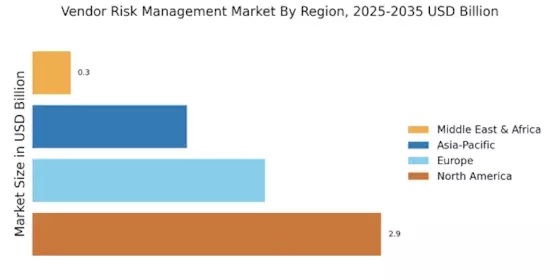The Vendor Risk Management Market is currently characterized by a dynamic competitive landscape, driven by increasing regulatory requirements and the growing complexity of supply chains. Key players are actively engaging in strategies that emphasize innovation, partnerships, and digital transformation to enhance their service offerings. For instance, RiskLens (US) has positioned itself as a leader in risk quantification, focusing on integrating advanced analytics into its platform to provide clients with actionable insights. Similarly, MetricStream (US) is leveraging its cloud-based solutions to streamline vendor risk assessments, thereby enhancing operational efficiency and compliance. These strategic focuses collectively shape a competitive environment that is increasingly reliant on technological advancements and customer-centric solutions.
In terms of business tactics, companies are adopting localized approaches to better serve diverse markets, alongside optimizing their supply chains to mitigate risks associated with vendor dependencies. The market appears moderately fragmented, with several players vying for market share, yet the influence of key players like RSA Security (US) and CyberGRX (US) is notable. Their combined efforts in enhancing cybersecurity measures and risk assessment frameworks contribute to a more robust market structure, where collaboration and innovation are paramount.
In August 2025, RSA Security (US) announced a strategic partnership with a leading cloud service provider to enhance its vendor risk management capabilities. This collaboration aims to integrate advanced threat intelligence into RSA's existing solutions, thereby providing clients with a more comprehensive view of their vendor risks. The strategic importance of this partnership lies in its potential to bolster RSA's market position by offering enhanced security features that address the evolving threat landscape.
In September 2025, CyberGRX (US) launched a new version of its vendor risk management platform, incorporating machine learning algorithms to automate risk assessments. This development is significant as it not only streamlines the risk evaluation process but also allows organizations to proactively identify potential vulnerabilities within their vendor networks. The integration of AI into their offerings positions CyberGRX as a forward-thinking player in the market, likely attracting clients seeking innovative solutions.
Moreover, in July 2025, Venminder (US) expanded its service offerings by acquiring a smaller firm specializing in third-party risk management software. This acquisition is indicative of Venminder's strategy to enhance its technological capabilities and broaden its market reach. By integrating new technologies and expertise, Venminder aims to provide a more comprehensive suite of services, thereby strengthening its competitive edge in the vendor risk management space.
As of October 2025, the competitive trends in the Vendor Risk Management Market are increasingly defined by digitalization, sustainability, and the integration of artificial intelligence. Strategic alliances are becoming more prevalent, as companies recognize the value of collaboration in addressing complex vendor risks. Looking ahead, it is anticipated that competitive differentiation will evolve, shifting from traditional price-based competition to a focus on innovation, technological advancements, and the reliability of supply chains. This transition underscores the necessity for companies to adapt and innovate continuously in order to maintain a competitive advantage.


















Leave a Comment